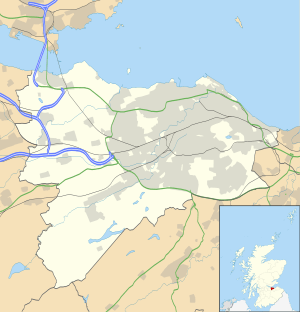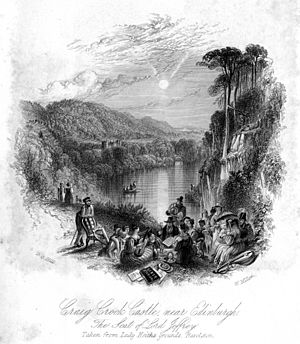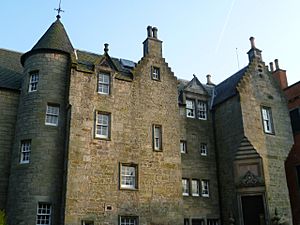Craigcrook Castle facts for kids
Quick facts for kids Craigcrook Castle |
|
|---|---|
| Edinburgh, Scotland | |
| Coordinates | 55°57′18″N 3°15′56″W / 55.9549515°N 3.2656914°W |
| Site history | |
| Built | 17th century |
Craigcrook Castle is an old and well-kept castle in Edinburgh, Scotland. It's about 3 miles west of the city center. Most of the castle was built in the 1600s, but parts were added later. In the 1800s, a famous lawyer and writer named Francis Jeffrey, Lord Jeffrey lived here. The castle became well-known for its fun gatherings where writers and thinkers would meet. Today, it's a special historic building, protected as a category B listed building.
Contents
History of Craigcrook Castle
The land where Craigcrook Castle stands belonged to the Graham family in the 1300s. Later, in 1362, it was given to the chaplains of St Giles' Cathedral. Over time, it had several owners. In 1542, William Adamson, a merchant from Edinburgh, took ownership. He owned many large areas in what is now north-western Edinburgh. Sadly, Adamson was killed in a battle in 1547.
The Adamson family either built or rebuilt Craigcrook Castle. They owned it until 1659. Then, it was sold to John Mein, another Edinburgh merchant. Ten years later, Sir John Hall of Dunglass lived there. He later became the Lord Provost of Edinburgh in 1689, which is like being the mayor of the city.
In 1682, Hall sold the castle to Walter Pringle, a lawyer. Pringle then sold it in 1689 to John Strachan. When Strachan passed away in 1719, he left the castle and its land for charity. This charity, called the Craigcrook Mortification, still owns the castle and its grounds today.
It's not fully known exactly when the castle was first built. However, its style suggests that most of it was constructed in the early 1600s. It seems an older, smaller fort was greatly rebuilt or made bigger at that time.
Famous Visitors and Literary Gatherings
In the early 1800s, Archibald Constable, a well-known publisher, lived at Craigcrook Castle. His son, Thomas Constable, who also became a publisher, was born there in 1812. After Constable, the castle became the home of Francis Jeffrey, Lord Jeffrey, a famous lawyer and literary critic.
Lord Jeffrey added a new drawing room to the castle. He also asked David Roberts to decorate the library. Later, in 1835, he hired William Playfair to update the main building. During the time Constable and Jeffrey lived there, many famous people visited. These included the famous writer Sir Walter Scott. Henry Cockburn, Lord Cockburn, another important figure, was also a frequent guest for many years.
It is said that Lord Jeffrey's ghost still haunts the castle!
Another person who lived at Craigcrook Castle in the 1800s was the writer and politician William Stirling. In 1855, he let the English poet Gerald Massey use the castle grounds. Massey later wrote a poem called Craigcrook Castle, which is one of his most famous works.
After Lord Jeffrey passed away, John Hunter Watt became the tenant. During the 1800s, Craigcrook Castle was famous for its literary parties. Many important writers and thinkers attended these gatherings. Guests included Charles Dickens, Hans Christian Andersen, George Eliot, and Lord Tennyson.
Recent History
Later additions were made to the castle, like a billiard room around 1891. Another part was added in 1968 when the castle became an office for architects. The castle was officially protected as a historic building in 1970.
From 1986 to 2004, Craigcrook was the Scottish office for a large fish-farming company. The inside of the castle was restored in 1989. After that, a building company used it as an office until 2014. At that time, it was put up for sale as a home.
What Craigcrook Castle Looks Like
The castle is located near Corstorphine Hill. It was a perfect country house, close enough to the city. Old records describe it as "the most ancient building in the parish."
Craigcrook Castle started as a Z-plan tower house. This means it had a main rectangular block with towers at opposite corners. Over the years, many parts were added, so it now has a mix of different building styles. There is a round tower on the southwest side and a square tower to the northeast.
The main part of the castle is about 60 feet long and 20 feet wide. It has three floors. The ground floor used to have arched ceilings, and so does the top floor of the round tower. The round tower is about 20 feet across. The square tower has sides that are 17 feet long.
The castle also has an entrance tower built by Playfair. You can see special features like "crow-stepped gables" (stair-shaped roof edges) and "pediment dormer windows" (windows with triangular tops). Some of the interior decorations from the 1800s are very interesting, including wall paintings by David Roberts.
A wall from the 1600s still surrounds the garden. It has an arched gateway with a special carved stone above it, dated 1626.
Modern Day Use
Craigcrook Castle was put up for sale in 2014 but did not sell. Now, plans are underway to turn this historic castle into a care home.




